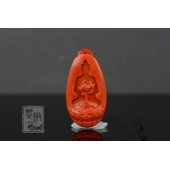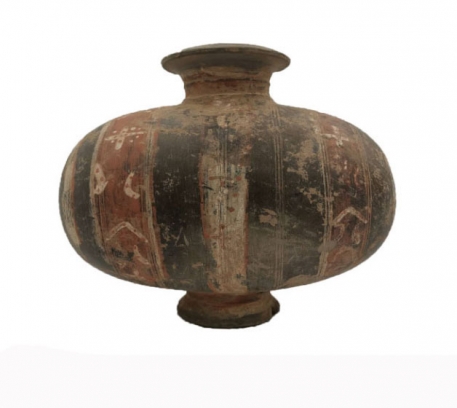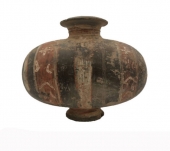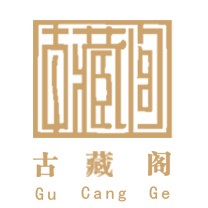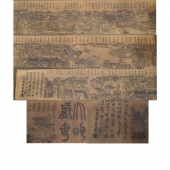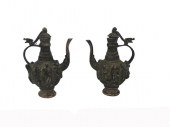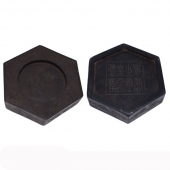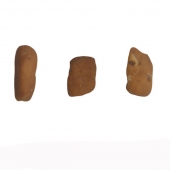汉代彩绘茧型壶
(平台服务时间:周一到周五 9:00-17:00)
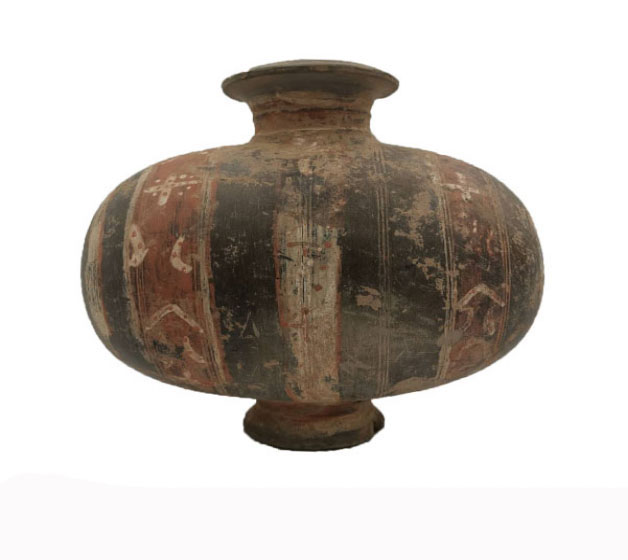
- 资质:
- 评分:
1分 2分 3分 4分 5分 6分 7分 8分 9分 10分 7分
- 印象:
- 经营时间:2023年
- 展厅面积:1500平米
- 地 区:重庆-渝北
| 创作年代 | 不详 | ||||
|---|---|---|---|---|---|
| 作品分类 | 其他 | ||||
| 作品标签 | |||||
| 适用空间 | |||||
作品介绍

汉代彩绘茧形壶,尺寸一般宽26至38厘米,高24至36厘米不等,绘有卷云纹或卧蚕纹,施朱砂、白、青蓝等矿物彩, 壶口微敞,腹部如茧形呈横向长椭圆状,周身暗刻有弦纹装饰,故名茧形壶,也有俗称鸭蛋形壶。茧形壶创烧于战国时期秦国,到了秦代达到鼎盛,后盛行于西汉,约在东汉之后逐渐消失。壶腹或彩绘流云、几何图案,或仅以暗刻弦纹装饰。由于色彩绘陶是烧成后再着色,它的颜色没有经过焙烧,与坯胎粘结不实,很容易脱落。此彩绘茧型壶的造型与纹饰,充分体现了汉代那种阳刚之美的大气磅礴的时代精神。
伴随古代丝绸业的发展,茧形壶出现于战国中期,是我国先民出于对桑蚕“天虫”的崇拜,祈愿农蚕丰产而创烧的陶器,多为日常容器。据传,它还有另外一个用处,早在战国时代,诸候之间相互争霸称雄,军队作战就用它来测量敌我之间的距离。古人将这种陶壶埋在地下,注水后可以听到远方马队传来的声波。军中培养出的测听者,通过陶壶声音和水波的细微不同,能测量出敌人的数量和距离。这种茧形壶可谓是战国时期的军事“土雷达”了。以此来推测敌军动向,这充分体现了古人的聪慧和机智。
历经2000多年的汉代彩绘茧形壶,至今保存完好,这是高古陶器入土2000多年的物理变化,是到代老旧的特征。2000多年过去了,矿物彩绘发色依然鲜艳如新,造型、绘画精美大气,是汉朝灿烂辉煌文明的缩影。汉代将彩绘陶器发展到了高峰,为随后而来的原始瓷器艺术的发展打下了坚实的基础,是我国陶器和陶瓷艺术发展的一个重要时期,创烧出了中国原始瓷器,是中国陶瓷历史上的一个重要转折点。随着时间的推移和朝代的变更,汉代彩绘茧型壶消失在人类文明进步的历史中,并且彩绘茧型壶有着不可复制的特性。现目前的仅存的汉代彩绘茧型壶都在博物馆中展出。汉代彩绘陶器由于历史久远,是研究我国陶瓷发展史、美术史、民俗社会史等的重要文物,备受有关专家和收藏家的青睐,文物价值和收藏价值越来越高。
该藏品是值得珍藏的一件陶器。有着非凡的收藏价值与意义,从而给收藏者带来了意想不到的财富,该彩绘茧型壶为研究战国时期的历史文化提供了宝贵的资料。品相完好,具有极高的收藏价值和艺术价值!
英语翻译:
Han Dynasty painted cocoon-shaped pots, generally 26-38 cm wide and 24-36 cm high, are painted with curly moire or silkworm pattern, with cinnabar, white, blue and other mineral colors. The opening of the pot is slightly open, the abdomen is transversely long oval, with string decoration carved on the body, so the cocoon-shaped pot is also commonly known as duck-egg-shaped pot. Cocoon-shaped pots were created and burned in the Qin State during the Warring States Period, reached their peak in the Qin Dynasty, then prevailed in the Western Han Dynasty, and gradually disappeared after the Eastern Han Dynasty. The ampulla can be painted with flowing clouds, geometric patterns or decorated only with hidden strings. Because the color painted pottery is colored after firing, its color has not been roasted, and it does not bond well with the tire, so it is easy to fall off. The shape and decoration of this painted cocoon pot fully embodies the great spirit of the times of the masculine beauty of the Han Dynasty.
With the development of ancient Silk industry, cocoon pots appeared in the mid-Warring States Period. They were pottery made by our ancestors out of the worship of "natural worms" of silkworm and prayed for high yield of silkworm, mostly daily containers. According to legend, it also has another use. As early as the Warring States Period, the warlords competed with each other and used it to measure the distance between the enemy and ourselves in military operations. The ancients buried the pottery pot underground, and after water injection, they could hear the sound waves coming from the distant horse team. The audiometers trained in the army can measure the number and distance of the enemy through the subtle difference between the sound of pottery pots and water waves. This cocoon-shaped pot is the military "earth radar" of the Warring States Period. In order to speculate the enemy's trend, this fully reflects the wisdom and wisdom of the ancients.
The painted cocoon-shaped pots of the Han Dynasty have been well preserved after more than 2000 years. This is the physical change of the high-ancient pottery which has been buried for more than 2000 years. It is the feature of the old age. More than 2000 years later, the color of mineral paintings is still bright as new, with exquisite shapes and paintings, which epitomizes the splendid civilization of the Han Dynasty. The Han Dynasty developed the painted pottery to the peak, laid a solid foundation for the subsequent development of the primitive porcelain art, was an important period for the development of China's pottery and ceramic art, created and fired the primitive Chinese pottery, and was an important turning point in the history of China's ceramics. With the passage of time and the change of the dynasty, the color-painted cocoon pot of the Han Dynasty disappeared in the history of the progress of human civilization, and the color-painted cocoon pot has the characteristics of non-replicability. The only existing painted cocoon pots of the Han Dynasty are on display in the museum. Because of its long history, the painted pottery of the Han Dynasty is an important cultural relic for studying the development history of China's ceramics, art history, folk social history and so on. It is favored by relevant experts and collectors. The value of cultural relics and collection value are getting higher and higher.
The collection is a pottery worth collecting. It has extraordinary collection value and significance, thus bringing unexpected wealth to collectors. The painted cocoon pot provides valuable information for the study of the history and culture of the Warring States Period. Good taste, with a very high collection value and artistic value!
阿拉伯语:
هان لون الطلاء شرنقة على شكل وعاء ، عموما على نطاق واسع 26 -38 سم ، 24 -36سنتيمتر متساوية ، رسمت مع توالت سحابة أو دودة القز خطوط ، الزنجفر ، الأبيض ، الأزرق ، وغيرها من الألوان المعدنية ، وعاء صغير مفتوح ، البطن مثل شرنقة على شكل أفقي طويل بيضاوي الشكل شرنقة وعاء على شكل حرق في فترة الدول المتحاربة ، تشين وصلت إلى ذروة الازدهار ، ثم انتشرت في اسرة هان الغربية الامبوله أو رسمت الغيوم المتدفقة ، أنماط هندسية ، أو فقط لأن اللون رسمت الفخار هو اللون بعد اطلاق النار ، فإنه ليس من السهل أن تفقد هذا الرسم الملون شرنقة نوع وعاء النمذجة والديكور ، تجسد تماما روح العصر مهيب
جنبا إلى جنب مع تطوير صناعة الحرير القديمة ، شرنقة على شكل وعاء يظهر في منتصف فترة الدول المتحاربة ، هو بلدنا الأجداد من العبادة ومن قال أن هناك أيضا استخدام آخر ، في وقت مبكر من فترة الدول المتحاربة ، في حين أن جميع مناحي الحرب تتنافس على بعضها البعض من أجل الهيمنة على بعضها البعض ، فإنه يستخدم لقياس المسافة بين العدو و بلدنا القدماء دفن وعاء من الفخار تحت الأرض ، ويمكن سماع موجات الصوت من بعيد المستمع الذي تربي في الجيش يمكن قياس عدد العدو والمسافة من خلال اختلاف طفيف في الصوت هذا النوع من شرنقة وعاء يمكن أن يسمى الأرض رادار عسكري في فترة الدول المتحاربة وبالتالي ، فإنه يدل على الذكاء والذكاء من القدماء
منذ سنوات عديدة على شكل شرنقة الأواني الملونة من سلالة هان ، والحفاظ على حالها حتى الآن ، وهذا هو التغيير المادي على مدى سنوات عديدة ، لون الطلاء المعدني لا يزال مشرق مثل الجديد ، والنمذجة ، اللوحة الجميلة الجو سلالة هان وضعت الفخار الملون في ذروة ، وضعت أساسا متينا من أجل تطوير فن الخزف البدائي في وقت لاحق ، هو فترة هامة من الفخار والخزف فن التنمية في الصين ، وخلق مع مرور الوقت ، وتغيير السلالات ، شرنقة وعاء الطلاء من سلالة هان اختفت في تاريخ الحضارة البشرية والتقدم في الوقت الحاضر ، فقط في عهد اسرة هان شرنقة الطلاء وعاء بسبب التاريخ الطويل ، سلالة هان الفخار الملون هو المهم الاثار الثقافية في دراسة تاريخ تطور الصين سيراميك ، تاريخ الفن ، قوم عرف التاريخ الاجتماعي
جمع هو قطعة من الفخار التي تستحق جمع هذا الرسم الملون شرنقة نوع وعاء يمكن أن توفر معلومات قيمة لدراسة التاريخ والثقافة في فترة الدول المتحاربة في حالة جيدة ، مجموعة عالية القيمة والقيمة الفنية
日语翻译:
漢代のカラーは繭形の壺を描き、サイズは一般的に幅26~38センチ、高さ24~36センチまで様々です。巻き雲の紋様や寝蚕の紋様が描かれています。朱砂、白、青などの鉱物彩を施して、壺の口は開けています。腹部は繭の形のように横に長い楕円形をしています。繭形壷は戦国時代に秦の国で焼きました。秦の時代には最盛期に達し、その後は西漢で盛んに行われました。壺の腹や彩色は流雲、幾何学模様を描いていますか?あるいはただ暗い刻みの弦の紋様で飾ります。色の絵陶は焼いてから着色しますので、色は焼きません。素地との接着が不実で、剥がれやすいです。この彩は繭型壺の造形と紋様を描き、漢代のような陽気で力強い時代精神を十分に体現しています。
古代の絹織物業の発展に伴って、繭形壷は戦国中期に現れて、我が国の先達者が桑蚕の“天虫”に対する崇拝からで、農蚕の豊産を祈願して燃やした陶器で、多くは日常の容器です。伝説によると、戦国時代には、諸候の間で互いに覇を競い、敵と味方の間の距離を測るために軍隊の戦いが行われたという。古人はこの陶壺を地下に埋め、注水した後、遠くの馬隊からの音波が聞こえた。軍で培った測定者は、陶壺の音と水波の微妙な違いで敵の数と距離を測ることができます。この繭形壺は戦国時代の軍事「レーダー」とも言える。これをもって敵軍の動向を推測することは、古人の知恵と機知を十分に表している。
2000年余りの漢代の色彩を経て繭形の壺を描いて、今なお完全に保存して、これは高古の陶器が土に入る2000年余りの物理の変化で、世代の古い特徴です。2000年以上が経ちましたが、鉱物の彩色は依然として鮮やかで新しさのようです。造形、絵画の美しい大気は漢の輝かしい文明の縮図です。漢代は彩色絵陶器をピークに発展させ、その後の原始磁器芸術の発展のために堅固な基礎を築きました。我が国の陶器と陶磁器芸術の発展の重要な時期です。時間の推移と時代の変化につれて、漢代の彩絵繭型壺は人類文明の進歩の歴史に消え、繭型壺は複製できないという特性を持っています。現在残っている漢代の彩絵繭型壺は全部博物館に展示されています。漢代の色彩絵陶器は歴史が古いため、我が国の陶磁器の発展史、美術史、民俗社会史などの重要な文化財を研究するので、関係専門家と収集家の愛顧を受けて、文化財の価値と収蔵価値はますます高くなります。
この蔵品は貴重な陶器です。特別なコレクション価値と意義を持っていて、コレクターに思いがけない財産をもたらしました。戦国時代の歴史文化を研究するために貴重な資料を提供しました。品相は完璧で、極めて高いコレクション価値と芸術
作者介绍
卢付平, 男,1975年4月生,汉族,甘肃定西人。中国历史博物馆研究员、文物鉴定委员会委员。1993年毕业于南京复旦大学历史系(五年制)。自1996年起至今,一直在中国历史博物馆(现为湖北博物馆)工作,从事碑帖、法书编目,鉴定和研究工作,同时研究其它文物和历史。

 黄琦
黄琦 贾平西
贾平西 测试用艺术
测试用艺术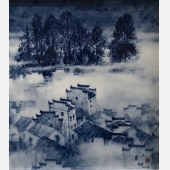 郭军
郭军